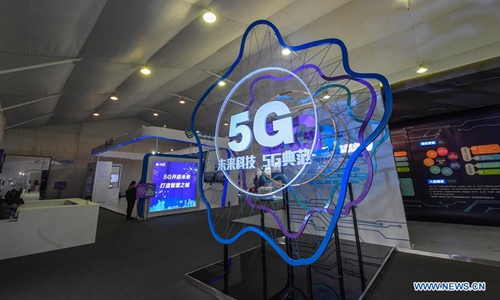SOURCE / INDUSTRIES
Ericsson doubles down on 5G, raises subscription forecast amid COVID-19 pandemic

A 5G technology exhibition is held in Hangzhou, east China's Zhejiang Province, Jan. 19, 2019. Photo: Xinhua
With the development of 5G technology and surging demand for connectivity via telecommunications, Swedish telecom equipment provider Ericsson increased its global 5G subscription forecast to 2.8 billion by 2025, nearly doubling its 2018 prediction.
Patrik Cerwall, head of strategic marketing at Ericsson, said during an online seminar on Monday the company is looking at some 2.8 billion 5G subscriptions globally by 2025. "So, we will get back to the trajectory pretty fast after this year," he said.
The COVID-19 pandemic, having claimed over 280,000 lives globally, is still ravaging normal economic activities, causing social isolation while triggering robust demand for networks to sustain teleconferencing and online education.
During an online address, Ericsson President and CEO Börje Ekholm highlighted the transformative changes the networks have experienced over the past two months. That shift has seen traffic move rapidly from business to residential areas in a matter of days. In many networks, traffic has increased by 20 percent.
Given the importance of connectivity, and 5G in particular as critical national infrastructure, Ekholm believed it is in the public's interest to ensure that pervasive, high quality, affordable, and secure networks are available when and wherever they are required.
Cerwall said China still witnessed an increase of 5G subscriptions nationwide for Q1 2020 when the country was hit hard by the pandemic. "But if you look at the rest of the world, we see a slight decrease, compared to our estimate," Cerwall explained.
Huawei, ZTE, Datang Mobile and Ericsson, won in April the bid for the joint procurement of wireless master equipment for 5G SA in 2020 by major Chinese carriers - China Unicom and China Telecom, which will purchase 250,000 5G stations and 5G equipment.
"5G deployment in Europe will certainly be delayed," said Huawei Rotating Chairman Eric Xu during a Huawei presentation in March. Xu also noted that the delays could last until "the time when the pandemic is brought under control."
Meanwhile, China accelerated 5G deployment as the pandemic subsided nationwide, according to Xu.
China has made continuous progress in 5G network implementation despite the disruptions caused by the health crisis. The country's 5G sector has been developing fast since it greenlighted 5G commercial use last June, with over 198,000 5G base stations built by the end of March, said Wen Ku, an official with the Ministry of Industry and Information Technology in April.
According to a report released in March by GSMA, an international association of mobile operators, 5G is forecasted to account for almost half of the country's mobile connections by 2025, representing an adoption rate on par with other leading 5G markets such as Japan, South Korea, and the US.
Global Times


